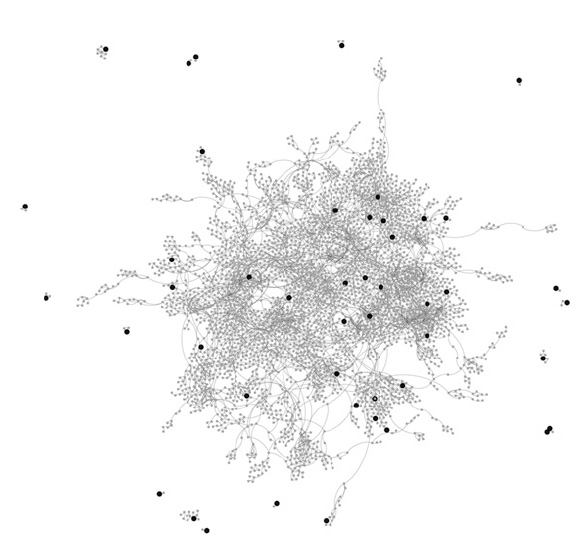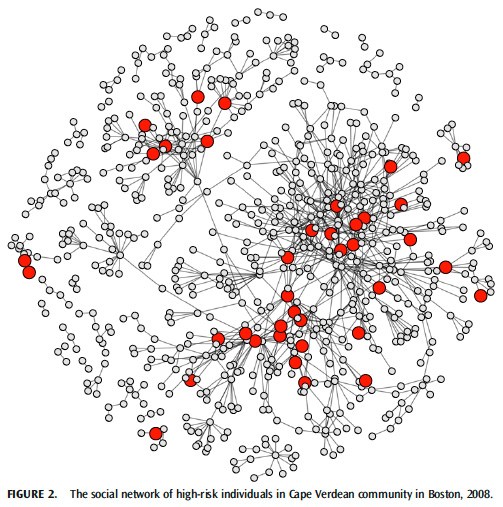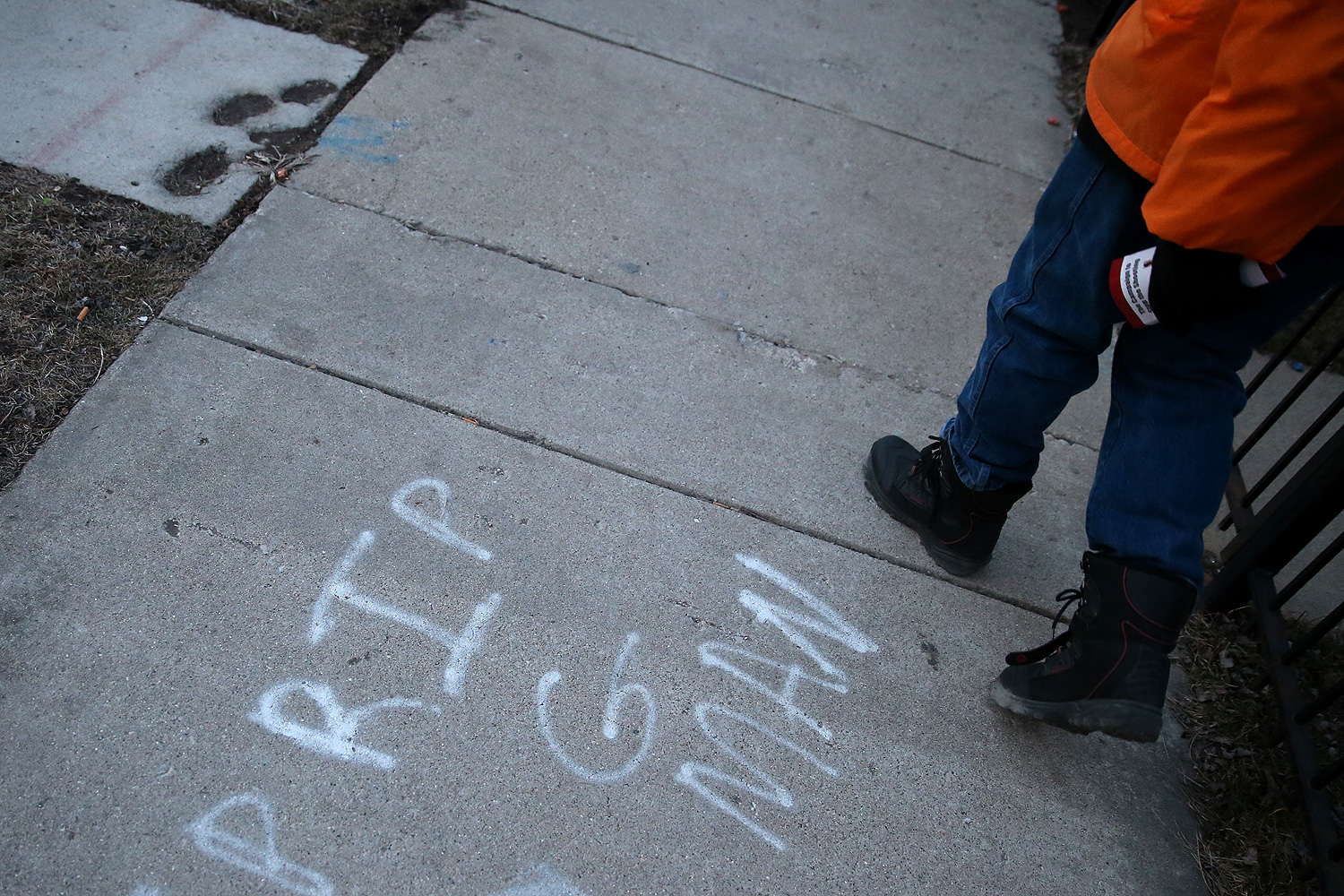CeaseFire and The Interrupters reframed Chicago crime to study the idea of violence as a virus, and it's become both a familiar metaphor and guide for real-world policy; "epidemic" is no longer just a scare word for homicide counts, it's a conceptual frame.
But the epidemiology of violence is still in its infancy, and as with any dimly understood virus, people are irrationally afraid of it—fearful they could pick it up on public transportation or by wandering into anywhere it's been known to spread. Is it airborne? What kind of contact do you need to pick it up? What does "risky behavior" entail when it comes to catching a bullet instead of catching a cold?
Andrew Papachristos, a Yale sociologist, Chicago native, and graduate of Loyola and the University of Chicago, has spent much of his career thus far chasing these lines of transmission, literally building up social networks of violence from the traces people leave in the criminal-justice system before they're shot or killed.
It's a theory in its early stages, one Papachristos likens to the kind of epidemiological work made famous in the early years of the AIDS crisis, as the method of transmission was reverse-engineered from what victims did and who they did it with—and suggests the possibility that the treatment could be similar, to "flood the network with services" with support when a person is at risk.
"The logic is something we've known for a long time, that it's who you mess around with that gets you in trouble," Papachristos says. But social-network theory accounts for who's messing around with the people you mess around with. "There are ways, especially now, that network science is evolving, that you can measure these things systematically, that you can see bigger patterns. It's not just about your friends and who you're hanging out with, it's actually the structure of these networks that matter."
Take, for instance, a 2013 paper, published with Yale colleague Christopher Wilderman in the American Journal of Public Health. It's set in a community in Chicago with a litany of familar risk factors: half of all households were led by a single female; 43 percent of the 82,000 residents had less than a high-school education; a third of households were below the poverty line. And the homicide rate, over the five years of the study, was 55.2 per 100,000, about four times the citywide rate (Daniel Hertz's maps of homicide rates by police district are a good way of putting that in context; it's high.)
And that's one way of looking at crime there: if you live here, this is your risk. And that's frequently how it's presented, and often how we think of neighborhoods in Chicago and elsewhere. But within this high-crime, high-risk neighborhood, there are very different levels of risk:
Simply being arrested during this period increases the aggregate homicide rate by nearly 50%, but being in a network component with a homicide victim increases the homicide rate by a staggering 900% (from 55.2 to 554.1).
What kind of social network would so increase your chances of being killed? Papachristos looked at people who had been arrested together, under the conservative assumption that the real world doesn't work like The Usual Suspects or Reservoir Dogs and that partners in crime generally know each other. And in that community, it was a staggeringly large network: 24,110 people, about a third of the population.
41 percent of the homicide victims in that community were located within that network, but only in a very small part of it: a mere 3,178 people, just four percent of the entire community. And this is what a social network of violence looks like:

Each node is a person; each dark node is a homicide victim. And many of those victims can be traced through these social ties of crime to one another. (There are likely very many more ties, since this captures only the people with the dumb luck of having been arrested together.)
Last year, Papachristos and two co-authors looked at a different result (gunshot injury) in a different place (the Cape Verdean community in Boston) using a different sort of data set ("field intelligence observation" cards from the Boston police). But the principle was basically the same: two people observed to be "associates" as recorded in the FIO cards. And the story was the same.

Translation [emphasis theirs]: "the closer one is to a gunshot victim, the greater the probability of one's own victimization." 85 percent of all the shooting victims were within a single social network, and the risk of getting shot dropped 25 percent each step an individual was removed from a victim.
But there are differences within these similarities. Even in this extremely abstracted form, from a third paper by Papachristos you can see a remarkable contrast between gang violence in Chicago and Boston. Each node is a gang; each line is a homicide or shooting; each bidirectional line is a reciprocal homicide:

Chicago's social network of homicide is a knotty mess: 98 percent of all Chicago gangs were connected within the city's homicide network during that timeframe, 32 percent higher than Boston's shooting network. The network density of black gangs in Chicago is particularly intense, 30 percent compared to 4.5 percent for Latino gangs.
"There's a lot more back-and-forth violence among the groups in Chicago then there is in Boston," Papachristos says. "It's just thicker. It feels like more stuff going on around you. It's like the Balkans in the '80s and '90s—everybody's warring with everybody else. The pattern's quite stable and quite distinct from Boston."
And Balkanized violence comes from generations of redrawn territories and historical tensions carried over the generations, grieveances refreshed anew even as the old structures that created them dissolve. "There are potentially a lot of reasons why that's the case," says Papachristos. "One, in Chicago, especially with black gangs we have a long history of high-rise public housing. The way it cut up different areas of the city became defined by that. If you ever want to increase interactions among people you shove them in big boxes going to produce all sorts of bad things.
"The second is that in Boston, the groups don't have as long a history. They're smaller, they don't endure the same way as in Chicago, so they don't build up this reservoir of conflicts. So in Chicago there are groups that have hated each other for 40 years and they don't even know why. The Two Six and the Latin Kings, they don't know why they hate each other, they just hate each other." (The former dates back to the 1970s; the latter to the 1960s. The city's largest gang, the Gangster Disciples, is about 50 years old.)
The thicket of deadly violence in the city looks ugly. But it's a clearer, more predictive picture than a checklist of isolated risk factors. "If you actually look at how these things are distributed in the population… it gets you past a straight profiling approach," says Papachristos.
Is it something we've always kind of known? Well, sure. CeaseFire, which brought the epidemeological approach to violence to the fore, is predicated on stepping in when violence happens and preventing its spread through the immediate social network. But it's still quite limited, as is policing, to snuffing out embers when they're already burning bright. It's also limited to an immediate, limited social network: when a shooting happens, who's most likely to take revenge?
Social-network theory looks past the immediate horizon of associates in crime to greater risk networks—to statistically establish levels of risk and establish the scope of the problem; to tease out similarities and differences between gangs both within and between cities; and to better target resources towards the most at-risk population.
One of the great dilemmas in criminology—and its substantial overlap with public health issues—is developing strategies for the medium-term. Traditional law enforcement and programs like CeaseFire are largely short-term, highly-targeted strategies; pre-K, pre- and post-natal care, job programs, and so forth are long-term, broad strategies.
Social-network theory, as it develops, could provide a foundation for medium-term strategies, providing a map for how public services can flow along social connections. If almost half of a city's homicide victims can be followed into a social community that's at ten times the risk of the already high-risk geographical community they live in, it gives both the police and public-services a place to start.
And a place to start for gathering more data—as Papachristos points out, his analysis is limited to people doing bad things. Robert Sampson, the Harvard (by way of Chicago) sociologist, has done pioneering work, most recently in his book Great American City, showing how positive social networks reduce crime and improve public-health outcomes in socially-organized neighborhoods like Chatham. Another possible implication is figuring out what kinds of networks "inoculate" people from violence.
"If I had blue-sky data and a bunch of money, I would really treat it like an infectious disease. I would do what we did with AIDS in the '80s and '90s, which is where you find a case—someone gets shot—you flood that part of the network with services," Papachristos says. "So, God forbid, you get shot, people show up–they learn about you, they check you in. What do you need? Oh, you have kids? Where are your kids, who's watching them? What do they need? Are they in school? Do you need help?"
Chicago, as Papachristos's network maps suggest, is an extremely complex city for such an approach—not just large, but with decades of conflicts creating tangled webs of violent relationships. But now he's in New Haven, which has long been a troubled post-industrial city, but one in which the annual number of homicide victims would barely fill a CPS classroom.
"You can do what we did with contact tracing and service support for people who had HIV in the early stages. That's how we worked needle exchanges. If we did that with violence, especially in smaller cities–Chicago's always going to be a huge challenge–but in New Haven, where if we have 30 homicides a year it's a bad year, there's no reason you can't do that with every one. There's no reason you can't get to know everything there is to know about those families with the resources that already exist and channel things accordingly."





Comments are closed.